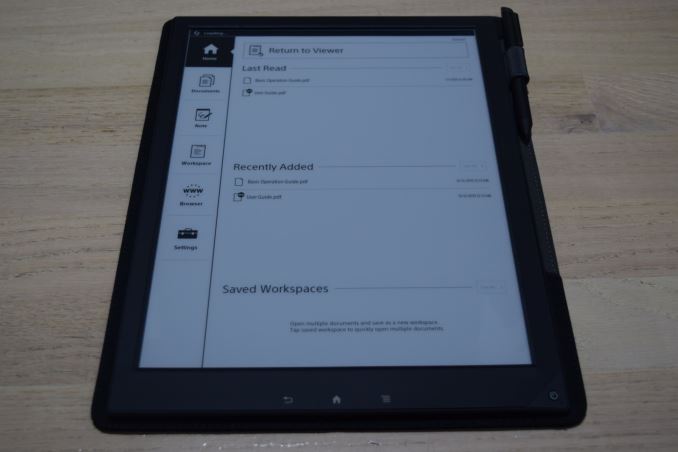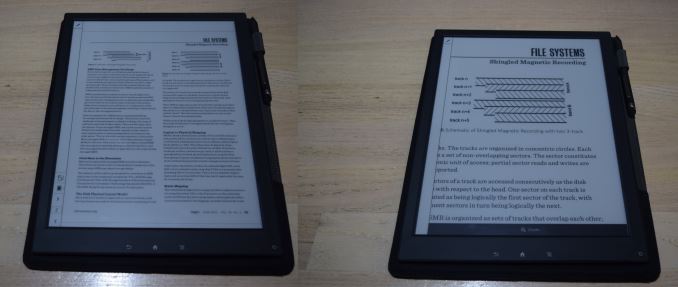Sony Digital Paper System DPT-S1 Review
by Ganesh T S on December 17, 2015 8:50 AM ESTSoftware and UI Aspects
The Sony DPT-S1 runs a Linux kernel, but the user interface shows no signs of Linux running under the hood. The setup process is quite straightforward - the time zone, date, pen grip style and an user name are the minimum required things to get started with the unit.
The main screen is organized in two panes. The smaller-width left pane provides the main options - a 'Home' view, 'Documents', 'Note', 'Workspace', 'Web Browser' and 'Settings'.
The 'Documents' section allows users to explore the file system (local storage as well as network drives) for PDFs. The 'Note' section allows for creation of handwritten notes (they are saved as PDFs).
The 'Workspace' section enables users to open a set of documents and group them for easy retrieval at a later time.
Available settings include user name configuration, Wi-Fi configuration (the standard scan, WPS and manual configuration options). Under server settings, one can set up a WebDAV account for syncing with the internal storage in the DPT-S1. While most users tend to use Box.com for this purpose, I decided to take advantage of the WebDAV features in my local QNAP NAS. Various application preferences (including those for the web browser) are also available, as shown in the gallery above.
It is also possible to calibrate the pen input to make sure that the writing appears at the correct place on the screen. The button on the pen can also be configured as an eraser (default) or highlighter. Firmware can be updated either from within the device (OTA) or by connecting to a PC.
The web browser built into the firmware is passable. At short notice, it is possible to navigate to known download links and obtain PDFs instead of hooking the unit to a PC and transfer the downloaded file via USB. As of v1.5, it is possible to block pop-ups, enable or disable JavaScript.
The PDF viewer allows pinch to zoom, but the extent of zooming available is not close to what is available on PDF readers on PCs. The photographs below show the zooming function in action. PDFs can be annotated with the stylus / pen and they are visible when the same PDF is viewed on another device also. While annotating, it is possible to use either blue or red color (appears as different grayscale shades on the DPT-S1, but in the proper color on other devices), and the text can either be bold or normal.
Graphics-heavy PDFs do take some to load, but, once loaded, navigation and zooming have acceptable speeds.
Writing notes with the pen / stylus takes some getting used to. After a few scribbled notes, I was able to get the hang of things. It is possible to adjust the thickness of the lines as well as the color of the text. The software also allows the various toolbars, tabs, side menus etc. to be hidden. This allows maximum use of available screen estate for the document.
Since the DPT-S1 targets professionals, the firmware is quite stable and bug-free within the set of available features. We do have some suggestions for improvements in our concluding remarks.


































109 Comments
View All Comments
groundhogdaze - Thursday, December 17, 2015 - link
I'm wondering why there aren't more competing products? I definitely want one and I'm assuming there's a reasonably large market out there for this sort of device. I do own a kindle DX but the DPT-S1 would be so much nicer :)JoeMonco - Thursday, December 17, 2015 - link
Based on what evidence do you believe that there's a large market for such a device? The very lack of very many competing devices would prove just the opposite.sungamer - Monday, December 21, 2015 - link
Actually I think it's due to engineering problems. Large format e-ink displays are still difficult to make, and the fact is unless you're using a flexible system (such as Mobius used by Sony here) they're very much prone to breakage. Mobius is also very expensive (last I heard a 13.3 inch display would cost about $600, but I'm SURE that has come down a bit now), so the combination of price and engineering problems means that this category of products is at its infancy, rather than a lack of demand.benzosaurus - Thursday, December 17, 2015 - link
Speaking as an engineering student, I'd buy that thing in a heartbeat to replace my old iPad 2— if it cost, like, $100.digiguy - Thursday, December 17, 2015 - link
I had considered this but the price of over 1000$ was too much for something that can only display PDFs. Whats more, in Europe, it could only be bought from Japan, with menus in Japanese only. My ipad pro with similar size and aspect ratio, and a mat screen protector, can do much more for a similar price....ganeshts - Thursday, December 17, 2015 - link
Except that iPad Pro weighs a lot more and is bound to result in eye strain under continuous use.melgross - Thursday, December 17, 2015 - link
Yes. It does weigh more, but the eye strain concept is a lot of hooey. Billions of people use tablets and smartphones without getting eye strain. Billions more use laptops and desktops without having eye strain. The few that do get it are either sensitive to bright light, or simp,y have everything g adjusted improperly.Medical experts have already said that there's no difference to the eye with reflected or transmitted light screens. People who have the problem should either raise the brightness, or lower it, depending on how they have it set. It will make a difference.
And a tablet, like the iPad Pro, or others, are just vastly more useful than something like this, particularly at the price point.
ganeshts - Thursday, December 17, 2015 - link
All I can say is: Give an E-Ink device a try for a week and also repeat a similar workload with a carefully adjusted tablet / backlit display for a week, and you will be sure to feel the difference.Personally speaking, I tried reading a technical eBook on a tablet and also on the DPT-S1. I was able to read more pages in one go on the latter.
digiguy - Thursday, December 17, 2015 - link
I really think it depends on what you read.... and how... First of all, I think a mat screen is a must. I really don't understand why people don't use them. All my tablets have a mat screen, including the Surface pro 3 (and the pen works perfectly). Then it's also a matter of adjusting brightness... Then there are books where colors are important and this device has no colors... As far as the weight is concerned, I think it depends. I never hold the ipad pro or surface pro 3 with just one hand vertically. Instead, the lower part is on my legs if I am sitting or, if I am standing, I hold it like a pizza. And it's not heavy at all like that. Now my main use was for sheet music. And for that weight is irrelevant. I wanted an A4 format, and Surface pro 3 was a bit smaller than ideal... Ipad pro is perfect, as close to A4 as it gets. Also for a large majority of my ebooks and scores 4:3 works better than 3:2. Now, I am not saying that weight and eye strain don't matter or that this device is not better on these 2 points, but that I believe there are workarounds that make then "less relevant". It's all a matter of trade offs. And at this price point this device means giving up a lot of what an ipad pro can do. Sure the price has come down, but this is IMO an already old device (thats probably why Sony paid for this review) that should probably be refreshed or upgraded and/or sold at a more reasonable price point....ganeshts - Thursday, December 17, 2015 - link
whoa, dude! I paid $800 of my own money for this (Sony is not very liberal with review units unlike other manufacturers, btw) because I saw some value in it for my professional work as well as hobbies (solving crosswords and reading books). I thought AnandTech readers would like to hear the plus and minus points associated with the e-reader, and that is why I decided to write the review.
This type of blanket statement surprises me greatly.